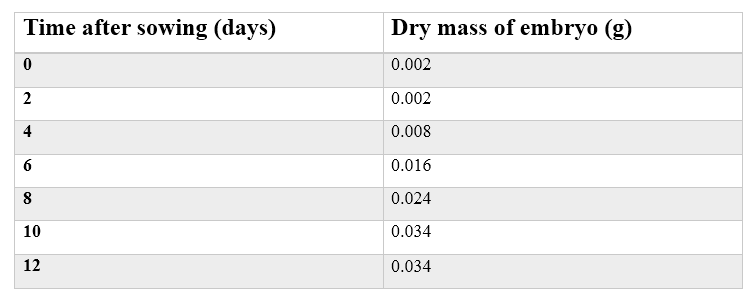Secondary Biology Reference Notes, Tutorials and Exercise QuestionsWhat is Measurement of Growth?
Growth can be estimated by measuring some aspect of the organism such as height, weight, volume and length over a specified period of time. The measurements so obtained if plotted against time result into a growth curve.
Study Question
The following results were obtained from a study of germination and early growth of maize.
The grains were sown in soil in a greenhouse and.at two-day intervals. Samples were taken, oven dried and weighed. See table.
Plot a graph of dry mass of embryo against time after sowing.
Describe the shape of the graph.
For most organisms when the measurements are plotted they give an S-shaped graph called a sigmoid curve such as in figure. This pattern is due to the fact that growth tends to be slow at first and then speeds up and finally slows down as adult size is reached. A sigmoid curve may therefore be divided into four parts. Lag phase (slow growth)
This is the initial phase during which little growth occurs. The growth rate is slow due to various factors namely:
Exponential phase (log phase)
This is the second phase during which growth is rapid or proceeds exponentially. During this phase the rate of growth is at its maximum and at any point, the rate of growth is proportional to the amount of material or numbers of cells of the organism already present.
This rapid growth is due to:
Decelerating Phase
This is the third phase during which time growth becomes limited as a result of the effect of some internal or external factors, or the interaction of both.
The slow growth is due to:
Plateau (stationary) phase
This is the phase which marks the period where overall growth has ceased and the parameters under consideration remain constant.
This is due to the fact that:
PRACTICAL ACTIVITY I: PROJECT
To measure the growth of a plant
Requirements Small plots/boxes, meter rule and seeds of beans (or green grams, peas, maize), Procedure
0 Comments
Leave a Reply. |
Archives
January 2024
Categories
All
|
Can't find what you are looking for? Don't worry, Use the Search Box Below.
|
Primary Resources
College Resources
|
Secondary Resources
|
Contact Us
Manyam Franchise
P.O Box 1189 - 40200 Kisii Tel: 0728 450 424 Tel: 0738 619 279 E-mail - sales@manyamfranchise.com |


 RSS Feed
RSS Feed

